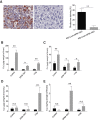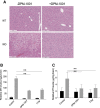DPM-1001 decreased copper levels and ameliorated deficits in a mouse model of Wilson's disease
- PMID: 29945887
- PMCID: PMC6075031
- DOI: 10.1101/gad.314658.118
DPM-1001 decreased copper levels and ameliorated deficits in a mouse model of Wilson's disease
Abstract
The levels of copper, which is an essential element in living organisms, are under tight homeostatic control. Inactivating mutations in ATP7B, a P-type Cu-ATPase that functions in copper excretion, promote aberrant accumulation of the metal, primarily the in liver and brain. This condition underlies Wilson's disease, a severe autosomal recessive disorder characterized by profound hepatic and neurological deficits. Current treatment regimens rely on the use of broad specificity metal chelators as "decoppering" agents; however, there are side effects that limit their effectiveness. Here, we present the characterization of DPM-1001 {methyl 4-[7-hydroxy-10,13-dimethyl-3-({4-[(pyridin-2-ylmethyl)amino]butyl}amino)hexadecahydro-1H-cyclopenta[a]phenanthren-17-yl] pentanoate} as a potent and highly selective chelator of copper that is orally bioavailable. Treatment of cell models, including fibroblasts derived from Wilson's disease patients, eliminated adverse effects associated with copper accumulation. Furthermore, treatment of the toxic milk mouse model of Wilson's disease with DPM-1001 lowered the levels of copper in the liver and brain, removing excess copper by excretion in the feces while ameliorating symptoms associated with the disease. These data suggest that it may be worthwhile to investigate DPM-1001 further as a new therapeutic agent for the treatment of Wilson's disease, with potential for application in other indications associated with elevated copper, including cancer and neurodegenerative diseases.
Keywords: Wilson's; chelator; copper; toxic milk.
© 2018 Krishnan et al.; Published by Cold Spring Harbor Laboratory Press.
Figures




Similar articles
-
N,N'-bis(2-mercaptoethyl)isophthalamide (NBMI) as a novel chelator for Wilson's disease.Free Radic Biol Med. 2025 May;232:421-436. doi: 10.1016/j.freeradbiomed.2025.02.046. Epub 2025 Mar 1. Free Radic Biol Med. 2025. PMID: 40032031
-
Activation of HIF-1 signaling ameliorates liver steatosis in zebrafish atp7b deficiency (Wilson's disease) models.Biochim Biophys Acta Mol Basis Dis. 2020 Oct 1;1866(10):165842. doi: 10.1016/j.bbadis.2020.165842. Epub 2020 May 21. Biochim Biophys Acta Mol Basis Dis. 2020. PMID: 32446740
-
Toxic milk mice models of Wilson's disease.Mol Biol Rep. 2021 Feb;48(2):1903-1914. doi: 10.1007/s11033-021-06192-5. Epub 2021 Feb 15. Mol Biol Rep. 2021. PMID: 33590415 Free PMC article. Review.
-
[Progress in drug therapy of Wilson's disease].Zhonghua Gan Zang Bing Za Zhi. 2024 Sep 20;32(9):783-786. doi: 10.3760/cma.j.cn501113-20240714-00324. Zhonghua Gan Zang Bing Za Zhi. 2024. PMID: 39375099 Review. Chinese.
-
Practical recommendations and new therapies for Wilson's disease.Drugs. 1995 Aug;50(2):240-9. doi: 10.2165/00003495-199550020-00004. Drugs. 1995. PMID: 8521757 Review.
Cited by
-
Wilson disease-treatment perspectives.Ann Transl Med. 2019 Apr;7(Suppl 2):S68. doi: 10.21037/atm.2018.12.09. Ann Transl Med. 2019. PMID: 31179305 Free PMC article. Review.
-
Latest innovations in the treatment of Wilson's disease.ILIVER. 2022 Sep 27;1(3):181-186. doi: 10.1016/j.iliver.2022.09.002. eCollection 2022 Sep. ILIVER. 2022. PMID: 40636798 Free PMC article. Review.
-
Pan-cancer analysis of cuproptosis regulation patterns and identification of mTOR-target responder in clear cell renal cell carcinoma.Biol Direct. 2022 Oct 8;17(1):28. doi: 10.1186/s13062-022-00340-y. Biol Direct. 2022. PMID: 36209249 Free PMC article.
-
Hepatic protein-tyrosine phosphatase 1B disruption and pharmacological inhibition attenuate ethanol-induced oxidative stress and ameliorate alcoholic liver disease in mice.Redox Biol. 2020 Sep;36:101658. doi: 10.1016/j.redox.2020.101658. Epub 2020 Jul 24. Redox Biol. 2020. PMID: 32769011 Free PMC article.
-
Protein tyrosine phosphatase 1B in metabolic and cardiovascular diseases: from mechanisms to therapeutics.Front Cardiovasc Med. 2024 Aug 22;11:1445739. doi: 10.3389/fcvm.2024.1445739. eCollection 2024. Front Cardiovasc Med. 2024. PMID: 39238503 Free PMC article. Review.
References
-
- Ahmad A, Torrazza-Perez E, Schilsky ML. 2017. Liver transplantation for Wilson disease. Handb Clin Neurol 142: 193–204. - PubMed
-
- Askari F, Innis D, Dick RB, Hou G, Marrero J, Greenson J, Brewer GJ. 2010. Treatment of primary biliary cirrhosis with tetrathiomolybdate: results of a double-blind trial. Transl Res 155: 123–130. - PubMed
-
- Boga S, Ala A, Schilsky ML. 2017. Hepatic features of Wilson disease. Handb Clin Neurol 142: 91–99. - PubMed
Publication types
MeSH terms
Substances
Grants and funding
LinkOut - more resources
Full Text Sources
Other Literature Sources
Medical
Molecular Biology Databases
Research Materials
